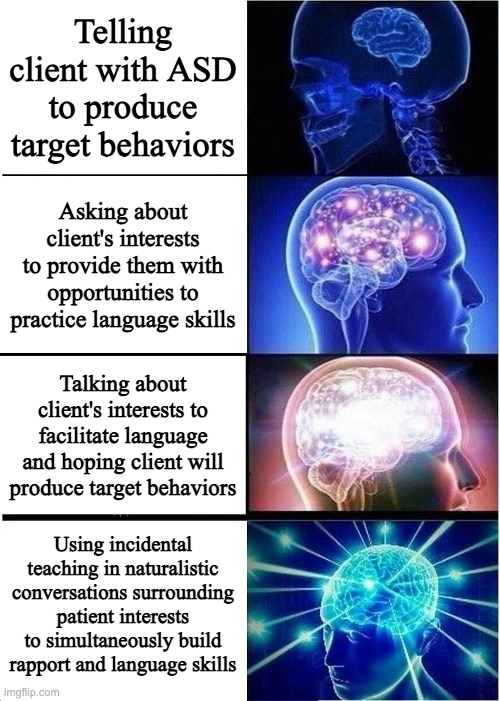Throughout this course, I completed Case-Based Practices (CBP) in which I presented my acquired knowledge on various cases through various media platforms. The cases taught appropriate considerations and facilitation techniques to use for clients with Autism Spectrum Disorder (ASD), voice feminization preferences, and child language impairments. For the case involving a client with ASD, I presented a meme about incidental teaching. Regarding voice feminization therapy, I created a brochure on cultural considerations for patients in the LGBTQIA+ community. Finally, for child language I focused my CBP poster on applications of the cloze technique. Each of these CBPs are shown and elaborated on below.
ASD CBP – Meme about Incidental Teaching

This meme addresses rapport building and facilitation techniques useful for working with individuals who are diagnosed with Autism Spectrum Disorder (ASD). The meme reads from top to bottom and illustrates the progression from an inactive brain to a brain using its full potential and firing a multitude of neurons. This progression corresponds to the captions on the left which describe the progression of thought process in a clinician contemplating the best method for providing treatment that fits the model of an Evidence-Based Practice (EBP). Three tenets make up an EBP; such practices are evidence-based and include both clinical expertise and the individual perspective of the client. One such EBP is incidental teaching. Incidental teaching is a facilitation technique in which the clinician systematically provides opportunities for the client to produce target behaviors within a naturalistic setting such as a conversation (Warren & Kaiser, 1986). Individuals with ASD typically have strong interests in specific topics so facilitating a conversation around their interests should make a rich context for incidental teaching.
References
(2021, December 11). Expanding brain. Imgflip. https://imgflip.com/i/5xjbzy
Warren, S. T. & Kaiser, A. P. (1986). Incidental language teaching: A critical review. Journal of Speech and Hearing Disorders, 51(), 291-299.https://doi.org/10.1044/jshd.5104.291
Voice Feminization CBP – Brochure on Cultural Considerations
Voice-feminization-1This CBP is a brochure organized for clinicians who are preparing for a client seeking voice feminization services. completing this CBP solidified the fact that cultural consideration – in this case, within the context of the LGBTQIA+ community – is an important factor that can guide me in writing goals with the individual in mind and choosing behavioral modification methods, among other aspects of therapy. Being able to incorporate cultural competence in every aspect of therapy is a skill that this CBP helped me practice. One of the main considerations necessary for working with a client who is in therapy for voice feminization is providing gender-affirming services. In goal writing, this can look like choosing objectives that fit within the client’s expectations and hopes in their transition while also fitting into the elements of the SMARTER goal model. In discrete trials, gender affirmation can look like creating opportunities that are functional and realistic for the client’s social participation. Facilitation techniques can also be gender affirming by ensuring safe and adequate support for the client’s voice and behavior modification methods such as positive reinforcement are gender affirming through productive motivation. Through this CBP I confirmed that cultural competency is an essential part of deciding on EBPs for clients since the client’s culture likely drives their individual preferences and perspective, which is one of the three prongs that define an EBP.
Child Language CBP – Poster on Cloze Technique
cloze-technique-1This CBP is in the form of a poster and addresses a specific facilitation technique for child language patients: the cloze technique. The poster addresses potential uses for the cloze technique (e.g. for requesting labels, descriptions, or interpretations) and the considerations (e.g. using culturally appropriate materials) necessary for application. In completing this CBP, I was able to learn more about the efficacy of this evidence-based practice and the multiple applications it has. For instance, if a child is working on reading comprehension then I can use a book that fits within their zone of proximal development and use its content as prompts for the cloze technique. If a child is working on expanding syntactic complexity, I can use the cloze technique to request descriptions or interpretations which can prompt for longer answers than requesting a label. As an aspiring SLP, I recognize the cloze technique as a possible tool to help children with language impairments. I also know that I must be culturally considerate of the materials I choose for the child since the patient may not have been previously exposed to certain nursery rhymes or books that are common materials used for the cloze technique.